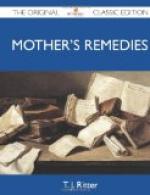If the bride wears a traveling dress she has a maid-of-honor, the one attendant being so-called. The groom is attended by his best man. There are usually two ushers, though these may be omitted, The maid-of-honor wears some pretty costume which is in keeping with that of the bride. If the latter wears white, the attendant also wears white with colored trimmings. If the bride wears a veil, the maid wears a hat; the veil being the head covering of the bride.
[Manners and social customs 741]
The bridegroom wears a black frock coat, gray trousers, white waistcoat and tie, silk—not lawn, gray or white gloves, and patent leather shoes at a day wedding, The ushers are similarly attired, save that they may wear black waistcoats. Silk hats are worn.
Minor Particulars.—The bridegroom and best man will require a room. The clergyman expects a room where he may don his surplice or gown. The ushers may also require a room.
The bride’s mother receives the guests, her father remaining with his daughter to conduct her to the room where the ceremony is to be performed. A mother may perform this office if the father is not living. After placing his daughter’s hand in that of the clergyman, the father steps back a pace or two, awaiting the end of the service. Wedding music is played when the party is ready to enter, and may be continued, very softly, through the ceremony; it must not overpower the voices of the participants.
Guests should arrive at the hour named, leave wraps in hall or dressing room, and descend to the parlors. It is not expected that all will be seated, though a few chairs are provided for the elderly. The ushers stretch two lengths of white ribbon from end to end of the room, making an aisle for the little procession.
The clergyman, groom, and best man enter and take their places at one end of the room, when the music begins. Then come the ushers, next the maid-of-honor, walking alone; then the bridesmaids, if any, followed by the bride on the arm of her father. The groom steps forward to receive her and the two face the clergyman. The best man stands on the bridegroom’s right. The maid-of-honor will hold the bride’s bouquet and her glove, if this is removed; the ring is in the custody of the best man.
Etiquette to be Observed.—At the close of the ceremony the clergyman congratulates the pair and steps aside. They face about and the bride’s mother is the next to offer her good wishes, then the groom’s parents. The guests then extend felicitations. It is thought in better taste to wish the bride happiness and congratulate the groom, it being supposed that he is the most fortunate in having been able to secure such a prize.
It is no longer customary for everyone to kiss the bride; she is not compelled to suffer to that extent.
The best man assists the ushers—whose first duty is to remove the white ribbons—in escorting guests to the bride and groom. His duties are the same as those of the best man at a church wedding.




